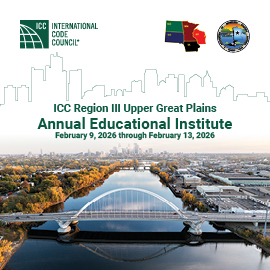
Release of ASCE/SEI 7-22 brings important changes to structural loading standard
Structural engineers are responsible for some of the most magnificent structures in the world that also protect the public’s health, safety and welfare. The building codes and referenced standards they use to design these projects ensure safety for us all. Developed by the Structural Engineering Institute of the American Society of Civil Engineers (ASCE), the Minimum Design Loads and Associated Criteria for Buildings and Other Structures (ASCE/SEI 7) standard is an integral part of the International Code Council’s International Codes (I-Codes), including the International Building Code, which is adopted widely in the United States and around the globe. The standard — revised and submitted to the code for adoption every six years ― is developed by a consensus development process that has been accredited by the American National Standards Institute (ANSI).
In December of 2021, the newly updated ASCE/SEI 7-22 is scheduled for release. The ASCE/SEI 7-22 standard provides the most up-to-date and coordinated structural loads standard for general structural design. This nationally referenced standard is ASCE’s most widely used publication and includes significant new provisions and technical updates, including the following:
- digital data available for all hazards at ASCE 7 Hazard Tool or equivalent;
- wind speeds along hurricane coastline, provisions for main force wind-resisting systems (MWFRS), and components and cladding of elevated buildings;
- chapter on tornado loads and effects, including new tornado wind speed maps;
- long return period hazard maps for wind and tornado;
- target reliability tables for tsunami and extraordinary loads;
- alternative method for loads from water in soil;
- terminology change from guardrail system to guard system and new live load provisions for emergency vehicles;
- tsunami data for Hawaii and many populous locations in California, coordinated with the state agencies and new tsunami provisions for above-ground horizontal pipelines;
- ground snow load data to reflect more recent snow load data and reliability-targeted values;
- revised method for estimating drifts to include a wind parameter;
- design rain load revisions to explicitly consider a ponding head;
- risk-targeted atmospheric ice load data for the continental United States and Alaska; and
- multi-period response spectrum data that eliminates need for Fa and Fv coefficients; lateral force resisting systems such as steel and concrete coupled composite plate shear walls, reinforced concrete ductile coupled shear walls, cross-laminated timber shear walls, and concrete tabletop structures; provisions for rigid wall, flexible diaphragm buildings (used in such projects as big box stores and warehouses); and provisions for supported and interconnected (coupled) nonbuilding structures.
The ASCE/SEI 7-22 standard is different from previous versions of ASCE 7 because the environmental hazard data is now provided in a digital format. As research and scientific methodologies improve, the ability to develop more detailed and refined environmental source data has increased dramatically. The ability for printed maps to depict every scenario is impossible. Therefore, while representative maps are included in the publication, ASCE/SEI 7-22 relies on digital data for all environmental hazards except wind and ice and the data is easily accessed through the ASCE 7 Hazard Tool or an approved equivalent source.
Another exciting change is that the ASCE 7 Hazard Tool is free to the user and open to the public beginning Dec. 1, 2021. The ASCE 7 Hazard Tool provides a quick, reliable way to access the digital data defined in the hazard geodatabases required by ASCE/SEI 7-22. The tool provides hazard data for all eight environmental hazards, including wind, tornado, seismic, ice, rain, flood, snow and tsunami. ASCE 7 Online, a digital product designed to support the new 2022 and previous 2016 editions, will also be updated and available in December 2021.
For technical information about ASCE/SEI 7-22, contact the Structural Engineering Institute.






